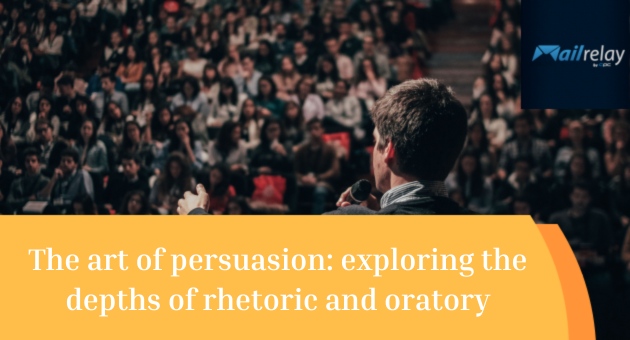
Rhetoric and oratory, two concepts whose origins date back to ancient civilizations, continue to play a crucial role in our society today.
More than mere communication skills, these disciplines constitute an art, a means by which ideas are transmitted, become influential and bring about change.
Rhetoric, derived from ancient Greece, is the study and practice of effective persuasive speech.
It is not limited to the spoken or written word, but covers a wide range of techniques and tactics that can be used to influence, persuade and mobilize people.
Oratory, on the other hand, refers specifically to the art of public speaking. It is a form of rhetoric that focuses on direct communication and often public debate.
In this information age, where we are inundated daily with an avalanche of messages, the ability to stand out and persuade has become more valuable than ever.
Persuasion is at the heart of many of our everyday interactions, from business negotiations and political discussions to personal conversations and social media posts.
In this article, we will explore the art of persuasion through the lens of rhetoric and oratory.
We’ll learn about its rich history, discover its fundamental elements, practice essential techniques and reflect on its place in our contemporary digital society.
Join us on this journey into the depths of rhetoric and oratory.
- 1 Definition of rhetoric and oratory
- 2 The importance of persuasion in our society
- 3 History of rhetoric and oratory
- 4 The art of persuasion
- 5 Rhetoric and oratory techniques
- 6 Rhetoric and oratory in the digital age
- 7 Examples of rhetoric and public speaking in practice
- 8 Some examples of books to delve deeper into the subject
- 9 Conclusión
Definition of rhetoric and oratory
Rhetoric and oratory are terms that are often used interchangeably; however, it is important to understand the subtleties that differentiate each.
→ Rhetoric
Originating in ancient Greece with prominent philosophers such as Aristotle, rhetoric refers to the art and skill of using language effectively and persuasively.
Although often associated with public speaking, rhetoric encompasses all forms of communication, both written and spoken.
Rhetoric involves the strategic use of words to achieve a specific goal, which may be to inform, persuade or motivate an audience.
To do this, various rhetorical techniques and figures of speech, such as metaphor, alliteration, anaphora, among others, are used to enhance the speech and make it more impactful and memorable.
→ Oratory
Oratory, on the other hand, is a sub-discipline of rhetoric that focuses specifically on the art of effective and persuasive public speaking.
The aim of oratory is to communicate ideas and emotions clearly and effectively in order to influence, inspire, persuade or entertain an audience.
Oratory involves presentation skills such as voice control, gestures, audience management and speech organization.
In addition, a good speaker must be able to adapt to circumstances, respond to audience reactions and deal with unexpected situations.
Therefore, although all public speaking skills are rhetorical, not all rhetorical skills necessarily imply oratory.
The two disciplines complement and reinforce each other and together form the basis of the art of persuasion.

The importance of persuasion in our society
Persuasion plays an essential role in our society.
It covers an impressively wide range of our daily interactions and is intrinsically linked to the way we communicate and understand the world around us.
From an individual level to a broader context, persuasion is manifested in countless ways.
In our personal relationships, persuasion can be used to resolve conflicts, motivate others or share ideas and feelings.
In the workplace, it is used to negotiate, lead, convince and collaborate effectively.
In a broader context, persuasion is a central pillar of democracy and governance.
Politicians, legislators and community leaders use persuasion to mobilize support, convey visions and promote change in society.
Marketing campaigns, media organizations and social networks rely on persuasion techniques to influence people’s perceptions and behaviors.
Persuasion also plays a key role in education.
Teachers persuade students to learn and engage, while students use persuasion to argue, debate and share knowledge.
Persuasion is a universally valuable skill and an essential tool for navigating and thriving in the world.
It is not just a manipulation technique, but a means of dialog, collaboration and change.
Rhetoric and oratory, as disciplines focused on the practice and study of persuasion, are vital to improving our ability to communicate and influence our society effectively.

History of rhetoric and oratory
To fully understand the relevance and influence of rhetoric and oratory in our world today, it is essential to look back in time, explore its origins and trace its evolution throughout history.
→ The origins of rhetoric: Greece and Rome
The origins of rhetoric can be traced back to ancient Greece, where it emerged as an important discipline in the 5th century BC.
During this period, the sophists, who were itinerant teachers of oratory and philosophy, taught people how to use persuasive speeches in debates and arguments.
The philosopher Aristotle was a pioneer in codifying rhetoric, and his work “The Rhetoric” remains an important resource to this day.
He defined rhetoric as the faculty of observing, in a given case, the available means of persuasion.
Rhetoric was later adopted and developed by the Romans.
The orator and politician Cicero and the educator Quintilian are notable figures from this period, with Cicero developing the concept of “eloquentia perfecta”, which suggested that good speech should be rooted in both moral wisdom and rhetorical skill.
→ Rhetoric and oratory in the Middle Ages and Renaissance
During the Middle Ages, rhetoric maintained its place in education, although its emphasis shifted from public oratory to written forms of communication, being used mainly in theology, poetry and diplomacy.
The Renaissance, with its renewed interest in classical teachings, saw a resurgence in the importance of rhetoric.
Renaissance humanists such as Erasmus of Rotterdam and Thomas More reinforced the idea that rhetoric was an essential tool for education and the formation of moral character.
→ The emergence of modern oratory
In modern times, rhetoric and oratory underwent significant changes, adapting to the changing needs of society.
Public speeches have played a crucial role in historical events, from the French Revolution to the civil rights movements of the 20th century.
Speakers such as Martin Luther King Jr. and Winston Churchillhave become historical icons, demonstrating the power of oratory to inspire change and mobilize the masses.
In the current era, oratory has adapted to encompass more diverse media, including radio, television and, more recently, digital platforms and social media.
This evolution has expanded the reach and influence of rhetoric, but it has also brought with it new challenges and considerations for the art of persuasion.
Throughout history, rhetoric and oratory have proven to be powerful tools for persuasion, education and social mobilization.
They remain vital in our society today and will continue to evolve to meet the ever-changing demands of our digital age.

The art of persuasion
Persuasion is at the heart of rhetoric and oratory.
It is a complex process that goes beyond the simple transmission of information; it is about influencing the attitudes, beliefs, values and behaviors of others through strategic communication.
→ Fundamental elements of persuasion
Persuasion is based on three fundamental elements: the message, the sender and the audience.
The message is the information or argument to be conveyed. To be effective, it must be clear, coherent and relevant.
The sender is the person or entity communicating the message. They must have the credibility, authority and empathy to persuade the audience.
Finally, the audience is the receiver of the message. Their perception of and reaction to the message depends on their own beliefs, attitudes and previous experiences.
→ The power of arguments: Logos, Pathos, Ethos
To persuade effectively, a communicator must appeal to three aspects of human reasoning: logos, pathos and ethos, a triad conceptualized by Aristotle more than two thousand years ago, but still fundamental to modern rhetoric.
Logos refers to logical reasoning.
It is about persuading through clear, coherent and rational arguments.
To use Logos, you need to present data, facts, statistics, examples and other evidence to back up your assertion.
Pathos appeals to the emotions.
Human beings are emotional creatures, and our emotions can be a powerful force in motivating our decisions and actions.
Effective persuasion usually involves appealing to the fears, hopes, desires and other emotions of the audience.
Ethos refers to the credibility and character of the speaker.
To persuade others, we need to be seen as trustworthy, honest and authoritative.
This can be achieved by various means, including building a good reputation, demonstrating experience and knowledge, and projecting confidence and sincerity.
→ The importance of credibility in persuasion
Credibility is an essential component of persuasion.
If people don’t see the speaker as a reliable and trustworthy source of information, they are unlikely to be swayed by their message.
Credibility can be built and enhanced through various strategies, including demonstrating experience and knowledge, projecting confidence and sincerity, maintaining consistency and coherence of messages and building trusting relationships with audiences.
The art of persuasion is a complex skill that requires a deep understanding of the human aspects of reasoning, emotions and credibility.
However, with practice and reflection, anyone can improve their ability to persuade and influence others effectively.

Rhetoric and oratory techniques
Both rhetoric and oratory have a variety of techniques and tools that can be used to improve the quality and effectiveness of communication.
These techniques can be used both to improve the quality of the content of a speech and to improve the way in which it is presented.
→ Rhetorical tools: metaphors, allegories, analogies, etc.
Rhetorical tools are techniques that speakers use to make their speeches more persuasive, memorable and effective. They include:
- Metaphors: Metaphors are a form of expression that compares two things that are essentially different but have something in common. They help to create vivid images and convey abstract concepts in a more concrete way.
- Allegories: Allegories are stories, poems or images that can be interpreted to reveal a hidden meaning, usually moral or political. They allow speakers to convey complex messages in a more accessible and engaging way.
- Analogies: Analogies are comparisons that explain or clarify an idea by comparing it to one that is more familiar to the audience. They help simplify complicated concepts and connect new ideas to existing experiences and knowledge.
→ Eloquence and its role in public speaking
Eloquence is the ability to speak or write clearly, effectively and persuasively.
In oratory, eloquence refers to the way the speaker uses language, tone of voice, rhythm, cadence, pause, gestures and facial expression to enhance their message and capture the audience’s attention.
Eloquence is a skill that can be learned and improved with practice. It includes techniques such as voice control (tone, volume, speed), body language (posture, gestures), eye contact and the ability to adapt to the audience’s reaction.
→ Tips for improving your public speaking skills
- Preparation: before giving a speech, you should have a thorough knowledge of the topic you are going to speak about. A good knowledge of the subject will give you confidence and help your presentation become more fluent and convincing.
- Practice: regular practice is essential to improve your public speaking skills. You can practice at home, in front of a mirror, recording yourself and reviewing your performance, or practice in front of friends or family to receive feedback.
- Control your nervousness: it’s natural to feel nervous before and during a speech. However, there are techniques you can use to control nervousness, such as deep breathing, positive visualization and concentrating on the message and not on yourself.
- Interaction with the audience: A good speaker interacts with their audience. You can do this by asking questions, asking for feedback or simply through eye contact. This not only keeps the audience engaged, but also helps them to adapt and respond to reactions in real time.
- Clarity and conciseness: it’s important to be clear and concise when speaking in public. Avoid excessive use of jargon or technical terms and make sure that your main points are clearly articulated and supported by relevant evidence or examples.
With these techniques and tips, you can hone your rhetoric and public speaking skills and become a more effective and persuasive communicator.

Rhetoric and oratory in the digital age
We live in a time of profound digital transformation that has radically changed the way we communicate.
Rhetoric and oratory skills remain fundamental, but have been adapted to meet the needs and challenges of this new digital context.
→ The influence of technology on rhetoric and oratory
Technology has had a significant impact on rhetoric and oratory, affecting both the means and modes of communication.
Traditional means of communication, such as speeches and face-to-face presentations, have given way to more modern forms, such as blogs, YouTube videos, podcasts, webinars and social media.
This has allowed speakers to reach much wider and more diverse audiences, but it has also introduced new challenges, such as the need to capture and maintain attention in a digital environment full of distractions.
Social network companies and digital media have provided a new arena for rhetoric and oratory.
Social media platforms such as Twitter, Facebook, Instagram and LinkedIn allow speakers to communicate directly with their audience and share ideas using a more informal and personal voice.
However, these platforms also present unique rhetorical challenges. For example, messages must be concise and engaging, and often they must be accompanied by visual aids to attract attention.
In addition, speakers must be prepared to interact with the audience and respond to comments and criticisms in a timely and respectful manner.
→ Adapting your speaking skills for an online audience
Adapting your speaking skills for an online audience involves several adjustments. Here are some tips:
- Design your content for the screen: Make sure your content is visually appealing and easy to read on screens of different sizes. This can involve the use of slides, graphics, images and other visual elements.
- Make it interactive: Interaction is key to keeping your online audience’s attention. Consider including polls, questions and answers, chat and other forms of interaction in your presentations.
- Master the technology: Familiarize yourself with the digital platforms and tools you will be using in your presentation. Make sure you have a reliable internet connection and know how to solve basic technical problems.
- Pay attention to your screen presence: your body language and facial expression are still important, even when you’re online. Look at the camera to make eye contact with your audience and pay attention to your tone of voice and body language to convey your message effectively.
The digital age has brought with it new challenges and opportunities for rhetoric and public speaking. By adapting your skills to this new context, you can continue to communicate effectively and persuasively, regardless of the platform or medium you use.

Examples of rhetoric and public speaking in practice
→ Examples of rhetorical tools
- Metaphor: Martin Luther King Jr. used the “dream” metaphor in his famous “I Have a Dream” speech to create a vivid image of an egalitarian society.
- Allegory: George Orwell uses allegories in his novel “Animal Farm” to criticize totalitarianism.
- Analogy: In his speech “The Ballot or the Bullet”, Malcolm X uses the analogy of the “bullet vote” to argue that civil rights can be won through voting or violence.
→ Examples of eloquence
- Barack Obama is known for his eloquence, especially in his speech on race entitled “A More Perfect Union”, in which he addresses racial tension in the United States in a skillful and moving way.
- Winston Churchill, during the Second World War, inspired the British nation with eloquent speeches that are considered among the best in history.
→ Examples of rhetoric and oratory in the digital age
- In digital media, TED Talks are an excellent example of effective public speaking. Speakers from various fields use rhetorical skills to share ideas in presentations of 18 minutes or less.
- On social media, figures such as Greta Thunberg use platforms like Twitter to raise awareness about climate change, using rhetorical techniques to mobilize their followers.

Some examples of books to delve deeper into the subject
- Aristotle’s “Rhetoric”: This is one of the first and most influential works on rhetoric. Although the language is ancient, the fundamental ideas are still relevant today.
- “The Rhetoric of Advertising” by Paul Messaris: This book explores how rhetorical elements are used in advertising and propaganda, providing a fascinating analysis of rhetoric in a contemporary context.
- “Speak Like Churchill, Stand Like Lincoln: 21 Powerful Secrets of History’s Greatest Speakers” by James C. Humes: This book offers practical tips for public speaking based on the styles of some of history’s greatest orators.
- “Made to Stick: Why Some Ideas Survive and Others Die” by Chip Heath and Dan Heath: This book explores why some ideas “stick” and others don’t, with many ideas applicable to rhetoric and oratory.
- “Thank You for Arguing: What Aristotle, Lincoln, and Homer Simpson Can Teach Us About the Art of Persuasion” by Jay Heinrichs: This entertaining but informative book offers a tour of persuasion techniques used by historical and contemporary figures, including pop culture figures.
Conclusión
Rhetoric and oratory are fundamental skills that enable us to communicate ideas, influence others and navigate effectively in a variety of situations in everyday life.
As our society becomes increasingly digital, these skills continue to evolve and adapt, but their fundamental importance remains constant.
Looking to the future, we can expect rhetoric and oratory to remain an essential pillar of human communication.
As communication technologies and platforms continue to advance and change, individuals and organizations that are able to master the art of persuasion, both online and offline, will be in a strong position to influence, innovate and lead in the 21st century.
